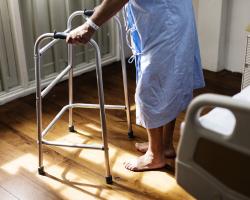Proper evidence protection and gentleness are the basic rules of attending to rape victims. The physicians should remember that their approach towards the raped woman can determine how soon she will regain mental balance.
The Office of the Government Representative for Equal Treatment has developed guidelines for attending to the victims of sexual violence, which are conditioned by the order taken by the victim, i.e. whether she notifies the police or a medical establishment first. The guidelines define the methods of securing evidence and places where the victim should be referred.
If the victim first notifies the police
When the – adult or juvenile – rape victim is taken to a medical establishment by the police, the main role of the physician is to conduct an interview and perform an examination in the presence of an assistant – a female physician, nurse, or midwife.
A person indicated by the victim can be present during the examination. This can be someone from the family or e.g. a representative of an organisation assisting rape victims. The physician should also call a psychologist.
At the request of the patient, the physician should administer a post-intercourse contraceptive. Action should also be taken to prevent sexually transmitted infections.
In the event of juveniles – girls – the examination is performed by a specialist in gynaecology and obstetrics, and in the case of boys – a paediatric surgeon or surgeon in cooperation with a specialist in gynaecology and obstetrics.
If the victim is unconscious, she should have blood and urine samples collected and a test for the presence of intoxicants or date rape drugs should be performed.
After the examination and the preservation of the evidence, the victim should be provided with replacement clothing and allowed to use the bathroom.
If the victim first goes to the doctor
If the sexual abuse victim comes to a medical establishment without prior notification of the police, the procedures are similar. The difference is that the physician must notify the police or prosecuting attorney, and in the case of juveniles, the parents or legal guardians as well.
In the event of a patient aged under 15, any sexual conduct must be reported, even if it does not fall under the definition of rape.
The victim should be informed of her rights in cooperation with a psychologist.
Today, the initiation of investigations concerning crimes against sexual freedom is not conditioned by the motion of the victim, but is automatic. Until recently, investigations concerning rape did not depend on just the notification of the crime, but the victim had to submit an official motion.
How the examination should be conducted
During the examination, the physician should establish whether there was sexual intercourse and whether the injuries result from violence, e.g. swelling, extravasation, bruises, and also to identify any injuries near the crotch and sex organs.
If the victim is a woman, a smear should be collected from the labia, the vestibule of the vagina, the back fornix of the vagina, and from the anal area. In the event of suspicion of oral sex, additional smear is collected from the oral cavity.
If the victim is a male, a smear is collected from under the foreskin, external part of the urethra, and from the anal area.
The physician should remember to preserve the material for bacteriological tests and the biological material according to the contents of the forensic kit provided by the police.
The biological material should also be preserved, including the pubic hair and samples from under each fingernail separately.









Comments (0)